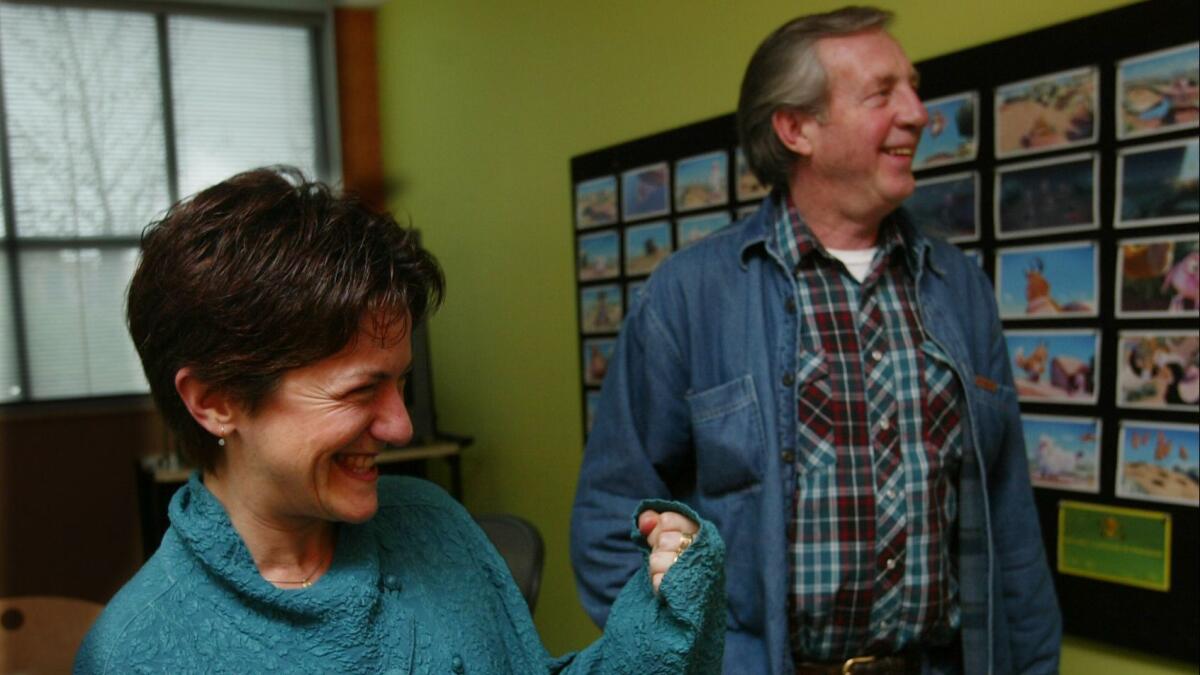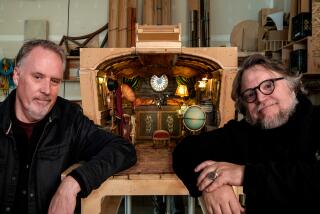Bud Luckey, Pixar animator who designed Woody from ‘Toy Story,’ dies at 83
- Share via
Bud Luckey, an Oscar-nominated animator who crafted hand-drawn, two-dimensional characters for more than three decades before using new digital tools to create Woody, the pull-string star of Pixar’s “Toy Story,” has died.
Luckey died Feb. 24 at a hospice center in Newtown, Conn. He was 83 and had suffered a stroke in 2013, said his son, Andy Luckey.
He began his career as a protege of Art Babbitt, the Walt Disney animator who developed the long-eared character Goofy and the wicked queen of “Snow White and the Seven Dwarfs.”
Working out of San Francisco, he animated the original “Alvin and the Chipmunks” television series, collaborated with “Peanuts” creator Charles M. Schulz on advertisements for Dolly Madison snack cakes, and devised entire segments for “Sesame Street,” in which his hillbilly-fiddler character Donnie Budd introduced young viewers to the numbers 2 through 6.
By the early 1990s, Luckey’s curiosity was piqued by plans for a computer-generated film at Pixar, the Bay Area studio that Apple co-founder Steve Jobs had helped establish in 1986. He was soon hired as the studio’s fifth animator and worked variously as a character designer, storyboard artist or voice performer for “Toy Story” (1995) and nearly every Pixar movie that followed.
Luckey was “one of the true unsung heroes of animation,” John Lasseter, who directed “Toy Story” and went on to become the studio’s chief creative officer, said in a 2004 Pixar documentary on the animator.
Known to some colleagues as Bud Low-Key, Luckey helped shape the whimsical worlds and characters of movies such as “A Bug’s Life” (1998), “Toy Story 2” (1999), “Monsters, Inc.” (2001), “Cars” (2006) and “Ratatouille” (2007).
He also performed voice work, lending his native Montana baritone to characters including government agent Rick Dicker in “The Incredibles” (2004), the despondent clown Chuckles in “Toy Story 3” (2010) and Eeyore in the 2011 adaptation of “Winnie the Pooh.”

Although animation is almost always a collaborative process, Luckey was granted near-total control of “Boundin’, “ a 2003 Pixar short that was shown in theaters before “The Incredibles” and received an Academy Award nomination for best animated short film.
Inspired by Luckey’s western upbringing, the five-minute movie featured a tap-dancing sheep who is shorn of his wool and his confidence but is encouraged to keep “bounding” by a friendly jackalope. Both characters were voiced by Luckey, who also directed and wrote the short and composed its banjo-driven score.
Still, he remained best known for his work on “Toy Story,” which set a benchmark for computer-generated animation and made more than $370 million worldwide.
The movie’s characters — toys that come to life whenever they are separated from their owner, who shared the same name as Luckey’s son, Andy — included an astronaut named Buzz Lightyear (voiced by Tim Allen) and, initially, a decidedly creepy-looking ventriloquist’s dummy.
Luckey suggested a change: Turn Woody (Tom Hanks) into a cowboy. “As soon as he said that, I knew it was just perfect,” Lasseter recalled in Karen Paik’s book “To Infinity and Beyond!: The Story of Pixar Animation Studios.” “The whole idea of a buddy picture is to pair up two characters who are as opposite as possible, and you can’t get more opposite than a spaceman and a cowboy.”
Luckey said he “did 200 Woodies,” sketching different possibilities with a pencil and pen, before Lasseter selected the rosy-cheeked version that appeared in the movie. Luckey and his Pixar colleagues — many of them half his age — then set to work turning the sketch into a computer-generated character.
“When I started working with a computer,” Luckey later told CBS, “to me it was kind of like animating with a backhoe. But when you see the results, it just blows your mind.”
William Everett Luckey was born in Billings, Mont., on July 28, 1934. According to family lore, he was known since childhood as Bud because an older sibling called him “budder,” mispronouncing “brother.” His mother was a schoolteacher, his father a commercial printer.
“When I was 4 years old I used to draw on the sidewalk with broken brick,” he told the San Francisco Chronicle in 2004. “Before World War II, I would draw Hitler and Mussolini and Tojo. And all the kids would gather round to spit and stamp on them. . . . That’s when I learned how to win friends and influence people.”
Luckey served as an artist and illustrator in the Air Force — he said he once accidentally spilled coffee on Gen. Curtis LeMay, who politely blew it off — and studied animation at the Chouinard Art Institute in Los Angeles, now part of the California Institute of the Arts.
His marriage ended in divorce. In addition to his son, who produced the animated series “Teenage Mutant Ninja Turtles,” survivors include two brothers.
Luckey was art director at the San Francisco-based ad agency Guild, Bascom & Bonfigli before working as a freelance animator for “Sesame Street” in the early 1970s. By the time he arrived at Pixar in 1992, he was surrounded by colleagues who had grown up watching Luckey’s segments on the show, including a memorable cartoon called “That’s About the Size” that zoomed out to show the relative size of an ant and a planet.
“I like to think these days that 30 years ago we used the animation to teach kids their numbers,” Luckey said in the 2004 documentary, “and now these kids are teaching me how to animate with numbers. So it was a good deal.”
More to Read
Start your day right
Sign up for Essential California for the L.A. Times biggest news, features and recommendations in your inbox six days a week.
You may occasionally receive promotional content from the Los Angeles Times.






